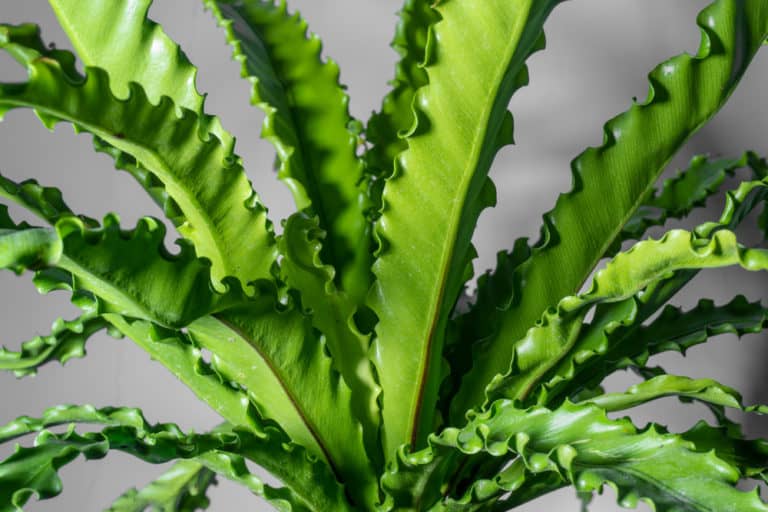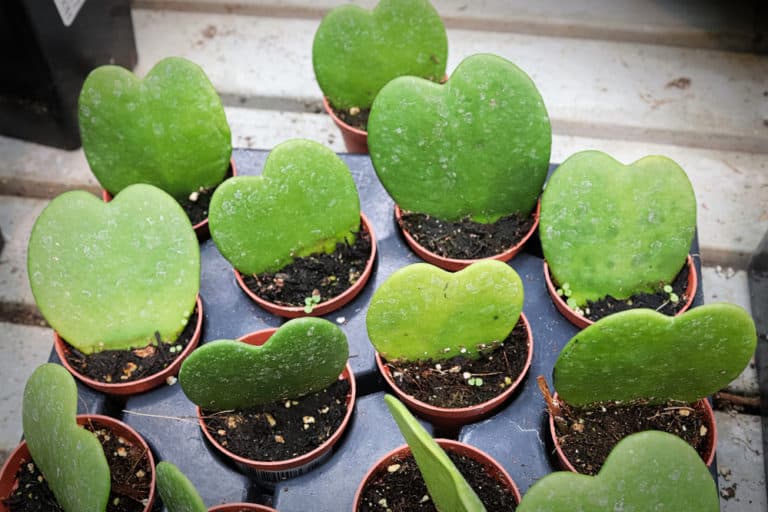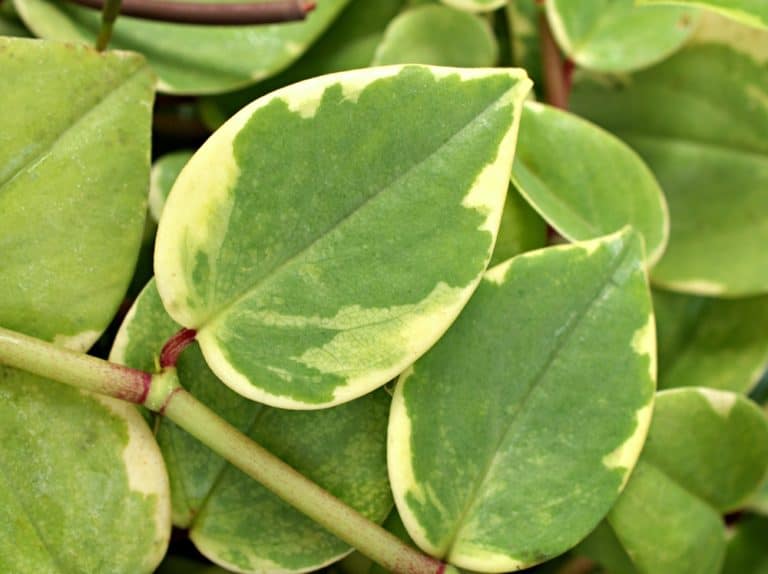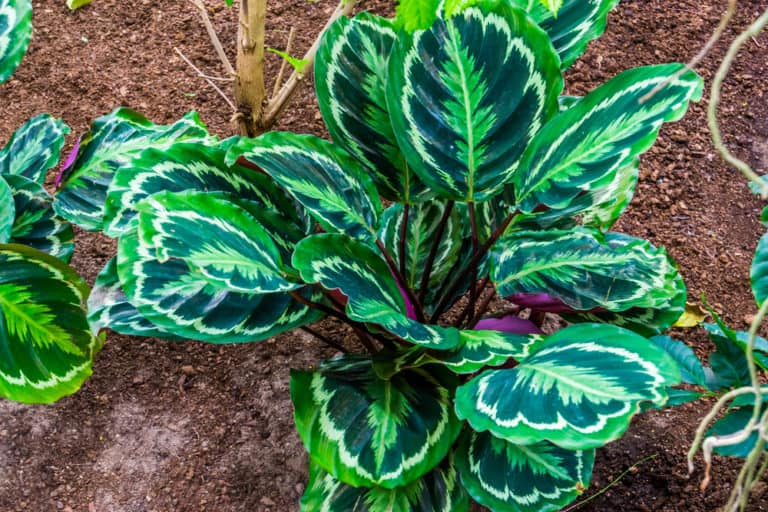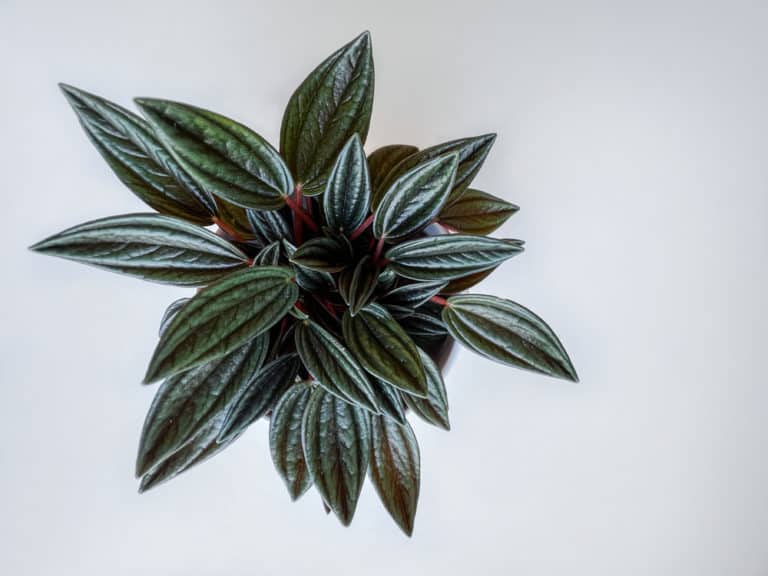Philodendron ‘Rojo Congo’ Care Guide (2024)
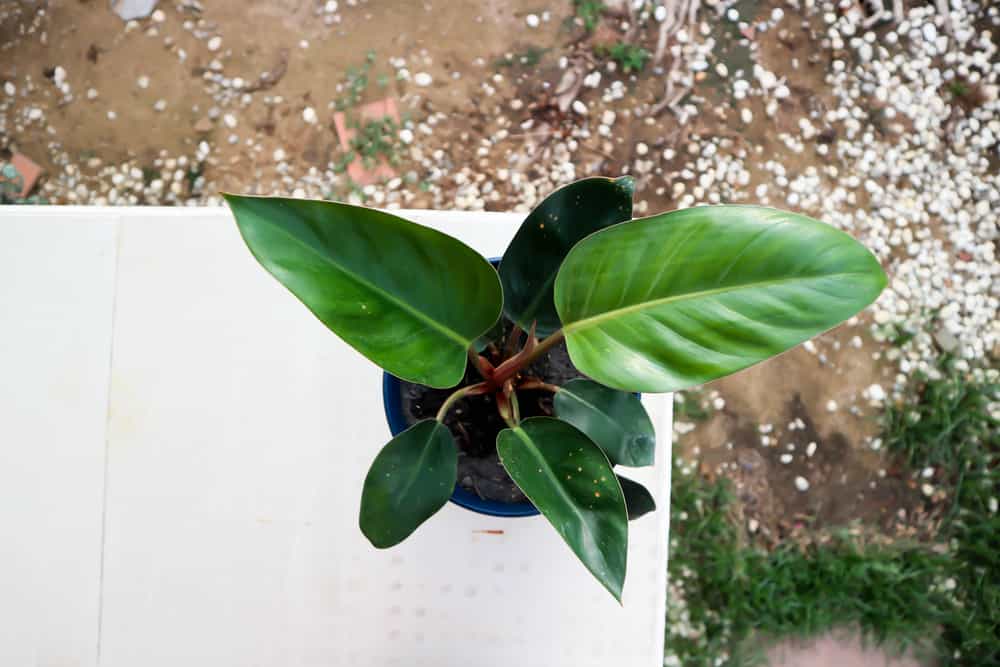
Philodendron Rojo Congo is a modern hybrid philodendron that has become a favorite of indoor gardeners in the past 20 years.
Rojo Congo’s deep green leaves and bright red stems create a stunning picture wherever you put this tropical beauty.
As well, its relatively compact size makes it ideal for even small spaces.
| Scientific Name | Philodendron tatei ‘Congo Rojo’ |
| Common Name | Philodendron Rojo Congo, Rojo Congo, Congo Red |
| Light | Bright indirect sunlight |
| Watering | Water if the top 2 inches of soil are dry |
| Temperature | 65 to 80ºF (18 to 27ºC) |
| Hardiness Zone | 9b to 12 |
| Humidity | 50% |
| Soil Type | Rich, quick-draining, loamy |
| Soil pH | 5.6 to 6 (acidic) |
| Fertilizing | A balanced feed once a month in spring and summer |
| Repotting | Every year |
| Pruning | Spring and summer |
| Propagation | Division |
| Toxicity | Toxic to humans and pets |
| Mature Size | 24 to 36 inches as a houseplant |
| Bloom Time | Rarely blooms indoors |
What’s Unique About Philodendron Rojo Congo?
Philodendrons are native to the tropical rainforests of the Americas, where they’ve evolved over time and mutated into many different cultivars.
While the Philodendron Rojo Congo plant was developed in Florida within the last 3 decades, its parent plants originated in Central and South America.
Philodendron Rojo Congo plants have large, glossy leaves that start out bright red and darken to a deep green when they mature.
Growing Philodendron Rojo Congo is easy, even for beginning gardeners.
As well, Philodendron Rojo Congo is a healthy choice for your home, as it is effective at filtering out harmful airborne chemicals such as formaldehyde.
Philodendron Rojo Congo Care
In the tropical rainforests where the philodendron family originates, these understory plants thrive in a warm and humid environment in dappled shade.
For your Philodendron Rojo Congo plant care, you need to understand these basic requirements.
The essentials of good Rojo Congo care are bright, indirect light, warm and humid conditions, and frequent light watering.
Light
Philodendron Rojo Congo may never have actually grown in the tropical rainforest, but it has inherited its Rojo Congo light needs from its wild forebears.
The bright sun overhead is tempered by the tree canopy that the rays pass through on their way to the forest floor.
In your home, Philodendron Rojo Congo light requirements are for bright, indirect light, or around 10,000 to 20,000 lux.
You will rarely have a need for plant lights to provide sufficient lux for your Philodendron Rojo Congo.
A north or east window will be just fine, while in a south or west-facing room you should find a place out of the full sun, which can do considerable damage to the leaves.
Watering
The goal of Philodendron Rojo Congo watering is to keep the soil evenly moist but never sopping wet.
In the rainforests, philodendrons are used to regular rain, but the soil they grow in drains quickly, so their roots are never submerged in water.
Water Rojo Congo whenever the top two inches have dried out. Don’t stick to a regular schedule, but rather check with your finger to see how wet things are first.
Philodendron Rojo Congo’s watering needs are best met with distilled or rainwater.
If you must use tap water, let it sit overnight in an open container to let the fluoride and chlorine gas off.
Temperature
The Philodendron Rojo Congo temperature range is 65 to 80ºF (18 to 27ºC).
While 65 (18ºC) is an adequate temperature for Rojo Congo, the higher temperatures will encourage faster growth and bigger leaves. After all, philodendrons are used to tropical temperatures in the rainforests.
Below 55°F (13°C), however, its temperature tolerance falls off drastically, and your Philodendron Rojo Congo may die if exposed for any length of time.
Keep it out of drafts and away from cold windows. Even being too close to an air conditioning vent can spell trouble.
Philodendron Rojo Congo has no frost hardiness whatsoever, so exposure to freezing temperatures will kill it.
Humidity
Philodendron Rojo Congo humidity requirements are moderately high, as the rainforests are naturally steamy.
The ideal humidity for Rojo Congo is 60% or more, but usually you can get away with a humidity level of 40%.
However, if you start to see brown tips or margins on your Philodendron Rojo Congo’s leaves, it’s time to come up with a way to increase the humidity for your tropical plant.
Misting isn’t terribly effective, as it provides a temporary boost, and wet leaves can foster disease.
You’re much better off setting a water-filled pebble tray under your Philodendron Rojo Congo, or buying a humidifier to help all your tropical plants thrive.
Soil
There are two key things to consider when choosing your Philodendron Rojo Congo soil: it must stay evenly moist, and it must drain well. These plants will not tolerate soggy soil.
The ideal pH level for Rojo Congo is 5.6 to 6, or acidic.
The easiest soil for Rojo Congo is simply 100% peat moss, which will both retain moisture and keep the roots from being drowned.
Adding a handful of well-rotted compost will save you from needing to fertilize your Philodendron Rojo Congo.
You can also buy a commercial aroid soil mix, which will not need any amendments.
Fertilizer
If you haven’t added compost to your Philodendron Rojo Congo soil mix, you will need to use a
Philodendron Rojo Congo fertilizer.
While you can use a fertilizer for Rojo Congo with a balanced fertilizer ratio, a nitrogen-rich formula such as 3-1-3 or 3-1-2 will encourage leaf growth.
A liquid fertilizer is the easiest to use. Dilute it to half the recommended strength and use it once a month, right after you’ve watered.
Pour it evenly over the soil surface for even absorption.
Do this monthly during its active growing season in spring and summer, and then stop during the fall and winter dormant phase.
Potting & Repotting
Philodendron Rojo Congo repotting should be done every year until the plant reaches its full size, which will take about 5 years.
Watch for roots growing out of the drainage holes to decide when it’s time.
After that, you should plan on repotting Rojo Congo every couple of years to refresh the potting soil.
When moving to a larger pot size, only increase it by an inch or 2 at most, as too big a pot will actually set your Philodendron Rojo Congo’s growth back.
Use a heavy ceramic or clay pot to counterbalance the weight of the plant, and always ensure it’s got drainage holes.
Pruning
You will hardly ever have to do any Philodendron Rojo Congo pruning.
This hybrid was bred to grow into a natural rosette shape, and will remain compact and neat without any shaping.
Most of the time, you will only be cutting Rojo Congo to trim off dead leaves. The outer leaves will naturally die off, and removing them will keep your plant looking its best.
Sometimes, you will have slight blemishes such as brown edges along the margins of your Philodendron Rojo Congo leaves. Rather than cut off the whole leaf, use small, sharp scissors to carefully trim off the damaged part.
Propagation
Good news! As of January 2022, Philodendron Rojo Congo’s patent expired, so it is perfectly legal to do Philodendron Rojo Congo propagation for any purpose.
The best way to propagate Rojo Congo is through dividing offsets, as the plant itself has already done most of the work for you.
This is easiest to do when you are repotting the plant and have removed the root ball from the pot.
Look for small plantlets growing around the edge of the mother plant. Gently tug them away, making sure that you’ve got a baby with both roots and stem.
Plant them out in their own pots.
Also, make sure to check out our in-depth Philodendron selloum plant care guide.
Common Problems of Philodendron Rojo Congo
Most Philodendron Rojo Congo problems are preventable or easily resolved.
You can avoid having problems with Rojo Congo by giving it as close as possible to its ideal growing conditions.
If your Philodendron Rojo Congo’s leaves show any signs of distress or poor health, you should immediately figure out the problem and then apply the proper solution.
Pests
Philodendron Rojo Congo pests include most of the usual suspects.
You can keep your Rojo Congo free of bugs by wiping down its large leaves once a month with an insecticidal soap or neem oil solution. This will keep your Philodendron Rojo Congo clean and free of insects.
Aphids are small, soft-bodied flying insects that can be found sucking the sap from stems and the underside of leaves.
Spider mites are rarely seen, but their webs and small yellow bumps on the leaves reveal their presence.
You can get rid of both these bugs by giving your Philodendron Rojo Congo a thorough showering.
Mealybugs hang out under the leaves, looking like clumps of white fluff. Use an alcohol-soaked cotton ball to wipe them off.
Diseases
If you keep your Philodendron Rojo Congo’s leaves dry and the soil just moist, you may well avoid any Philodendron Rojo Congo diseases.
However, if your Rojo Congo does get a fungal or bacterial disease, you need to work quickly to save your plant and stop it from spreading to the rest of your indoor garden.
Xanthomonas causes dark spots circled with yellow, with a nasty smell.
Erwinia blight leaves mushy, wet patches on the leaves that quickly spread and cover entire leaves.
Root rot turns leaves yellow and softens the stems, while turning once-healthy roots black and smelly.
For all of these diseases, remove all infected parts and dispose of them in the garbage. Replant your Philodendron Rojo Congo in fresh soil in a new pot.
Growing Problems
Resolving other growing problems is just a question of improving your Philodendron Rojo Congo’s growing conditions. Your sick plant should recover nicely once that’s done.
Faded leaves or legginess are both an indication that your Philodendron Rojo Congo isn’t getting enough light. Move it to a brighter spot and prune it to encourage new growth.
Dark patches on leaves or dropping leaves are both caused by exposure to too-cold temperatures. Keep it out of drafts and away from cold windows.
Brown leaves have been scorched by too much sun. Trim off the damaged foliage and move it away from the direct sun.
Toxicity of Philodendron Rojo Congo
Rojo Congo is toxic to humans and animals, although rarely fatally.
All parts of Philodendron Rojo Congo have calcium oxalate crystals, which can pierce sensitive tissues such as skin and membranes.
Because of its toxicity, exercise caution when growing Philodendron Rojo Congo in a home with young children and pets.
For Humans
While Philodendron Rojo Congo is toxic to humans, you should not have to worry too much if you take reasonable precautions.
You should always wear gloves when handling your Philodendron Rojo Congo, as even the sap can cause an irritating rash. Rinse it off if it gets on your skin.
Children are more likely to ingest some of the foliage, but they’re unlikely to do more than a little taste, as they will immediately experience pain.
Get them to rinse and spit, and give them something like a popsicle to ease the pain.
However, if their tongue or throat is swollen, take them to the emergency room at once.
For Pets
Pets are at risk of serious organ damage if they ingest some of the Philodendron Rojo Congo foliage.
Cats, dogs, and rabbits are all equally susceptible to the effects of ingesting calcium oxalate.
If your pet starts wheezing or drooling excessively, or has vomiting or diarrhea, take it to the veterinarian as soon as possible.
Before it gets to this point, consider placing your Philodendron Rojo Congo where it will be inaccessible to pets and children.
It can be put on a ledge or table out of their reach, as even at full size it will only be 3 feet at most.
Philodendron Rojo Congo Appearance
The spectacular Philodendron Rojo Congo appearance is defined by its large, dramatically colored leaves.
They range in color from intense orange-red to deep green with burgundy tones.
The Philodendron Rojo Congo plant naturally forms a graceful shape without any need for pruning.
While flowering is possible on plants grown outdoors, the blooms are unremarkable.
Foliage
The foliage of Philodendron Rojo Congo is dramatically colored, creating a stunning plant that is perfect in a contemporary setting.
A mature Philodendron Rojo Congo leaf is about 18 inches long and 12 inches wide, in an elongated oval shape.
New leaves unfurl from the center of the plant, and are a rich red. As they mature, they turn a dark green with burgundy tones, with bright red petioles.
You will have both mature and juvenile leaves at the same time, creating a contrast in colors.
The leaves have a thick, leathery texture, with a glossy surface.
Leaves should be wiped down once a month to keep them clean.
Flowering
It takes a few years before you have a chance of seeing a Rojo Congo flower, but it’s really not worth holding your breath for, and not likely to happen indoors.
Philodendron Rojo Congo flowering is barely noticeable, as the small, insignificant flowers are usually hidden beneath the large leaves. They have no scent.
Many growers simply cut off the flower stems when they emerge, as the energy that would go into blooming is better directed towards leaf growth.
Realistically, the chances of a plant grown indoors flowering is very low. Instead of trying to achieve the impossible, enjoy the spectacular leaves instead.
Size and Growth
The mature size of Philodendron Rojo Congo is a perfect fit for a city apartment or small home.
A Philodendron Rojo Congo grown outdoors in a tropical zone can potentially reach 10 feet height and spread in 5 years.
When it’s grown indoors in a pot it will get to maybe 3 feet tall with a similar spread. It has a moderate growth rate.
Philodendron Rojo Congo naturally grows into a compact rosette shape, with stems springing from a short central stem.
New leaves emerge from the center of the plant while the older leaves fall off starting from the bottom outside edge.
Philodendron Rojo Congo Fragrance
There is no discernible Philodendron Rojo Congo fragrance.
Even the rare flowers have no scent, and the foliage has no smell at all.
Of course, as Rojo Congo is a philodendron, it does have the ability to filter contaminants from indoor air, so it will have a very positive impact on your home’s environment.
As well, the lack of scent makes Philodendron Rojo Congo a perfect plant to use in public settings like shopping malls and medical centers. Some people have scent allergies and so fragrant plants are discouraged.
Even in your own home, you may prefer a plant without an overwhelming scent.
Suggested Uses for Philodendron Rojo Congo
Indoors, a Philodendron Rojo Congo plant can be used in a variety of locations, wherever you want a dramatic pop of intense color.
In a large bathroom, you can set it on a ledge or table, where it will enjoy the extra humidity every time you take a shower.
Use it as an accent plant in a contemporary living room where it will stand out against a white background.
It’s also a perfect plant for a shady spot on a balcony or patio in the hot summer months.
Of course, if you live in a tropical climate, you can grow Philodendron Rojo Congo as a landscape plant, where it will soon become a large, evergreen bush.
FAQ
What is Philodendron Rojo Congo?
Philodendron Rojo Congo is a recent hybrid philodendron cultivar from a Florida plant breeder, notable for its dramatically colored foliage. It is a popular houseplant.
How to identify Philodendron Rojo Congo?
Philodendron Rojo Congo has large, ovate leaves that start out orangey red before changing to dark green as they mature. It has deep red petioles and grows into a compact clump.
How to care for Philodendron Rojo Congo?
Philodendron Rojo Congo should be grown in loose, porous soil that is kept moderately moist, and kept in a warm, humid spot out of the direct sun.
How to grow Philodendron Rojo Congo indoors?
Philodendron Rojo Congo can be grown as a potted plant in a warm, humid location with bright, indirect light. Water lightly on a regular basis.
How to grow Philodendron Rojo Congo outdoors?
Philodendron Rojo Congo can be grown outdoors in growing zones 9b to 12 all year, or taken outside for the summer months in temperate zones.
How fast does Philodendron Rojo Congo grow?
Philodendron Rojo Congo grows moderately fast, taking about 5 years to reach its full size of 3 feet when grown indoors and 10 feet outdoors.
How tall does Philodendron Rojo Congo grow?
Philodendron Rojo Congo will grow to between 2 and 3 feet tall with a similar spread as a potted plant, or 10 feet tall and across outdoors in tropical zones.
How to make Philodendron Rojo Congo grow faster?
Philodendron Rojo Congo will grow the fastest when it is grown in very hot and humid conditions, with regular watering and bright but indirect light.
How to stake Philodendron Rojo Congo?
Philodendron Rojo Congo naturally grows into an upright shape without staking. You can rotate the pot a quarter turn weekly to keep it from developing a lean towards the light.
How to pot Philodendron Rojo Congo?
Philodendron Rojo Congo should be potted in loose, well-draining soil that retains a moderate amount of moisture. Use a heavy pot with good drainage holes.
How to revive Philodendron Rojo Congo?
If your Philodendron Rojo Congo has dried-out soil, try putting the pot into a pail of tepid water and letting the soil get saturated before draining the excess.
Why is my Philodendron Rojo Congo dying?
Your Philodendron Rojo Congo may have a bacterial or fungal disease. Once you have removed all the affected parts and repotted it, be careful with watering.
Why is my Philodendron Rojo Congo drooping?
Your Philodendron Rojo Congo may be drooping because its soil is too wet or too dry. Either soak it well or repot it in fresh, loose soil.
How cold can Philodendron Rojo Congo tolerate?
Philodendron Rojo Congo needs warm temperatures to thrive. It will not grow well below 55°F (13°C), and is likely to get damage to its foliage. Freezing temperatures will kill it.
How to get rid of pests on Philodendron Rojo Congo?
Philodendron Rojo Congo pests can be controlled by wiping down its leaves once a month with a solution of neem oil or insecticidal soap on a cloth.
Is Philodendron Rojo Congo toxic to cats?
Yes, Philodendron Rojo Congo is toxic to cats. If your cat starts drooling, vomiting, or wheezing after eating some foliage, take it to the veterinarian immediately.
Is Philodendron Rojo Congo toxic to dogs?
Yes, Philodendron Rojo Congo is toxic to dogs. If your dog is wheezing or drooling excessively, and has diarrhea or vomiting, take it to the vet.
Is Philodendron Rojo Congo toxic to children?
Yes, Philodendron Rojo Congo is toxic to children. If your child has a swollen tongue or difficulty breathing, take them to the emergency room at once.
Is Philodendron Rojo Congo toxic to humans?
Yes, Philodendron Rojo Congo is toxic to humans. The sap can cause a painful rash, so if it gets on your skin rinse it well.
Does Philodendron Rojo Congo have a scent?
No, Philodendron Rojo Congo has no scent. The rare flowers have no fragrance, and the foliage has no discernable fragrance, so it is safe to use around people with scent allergies.

